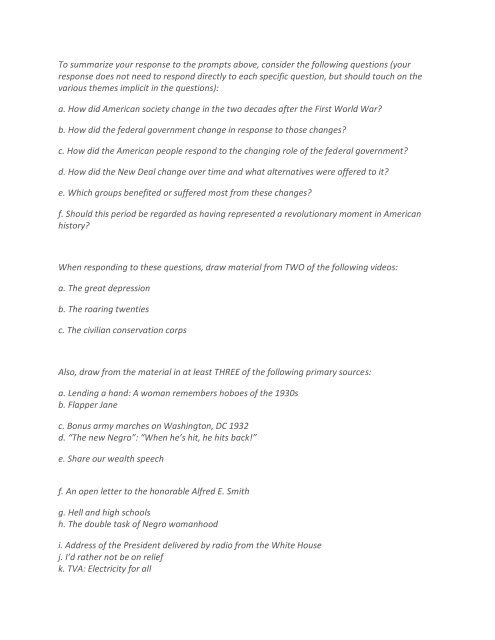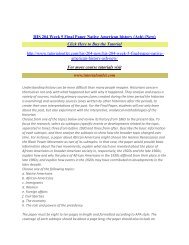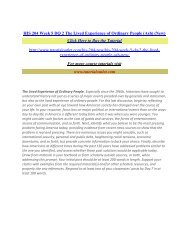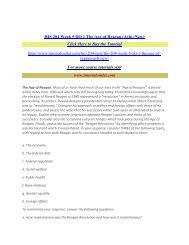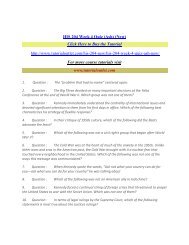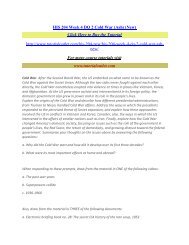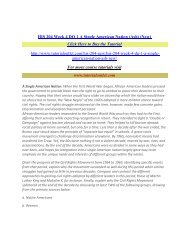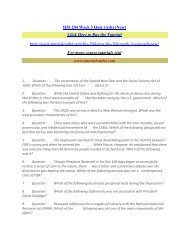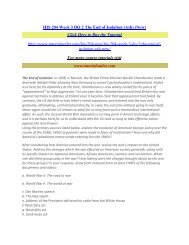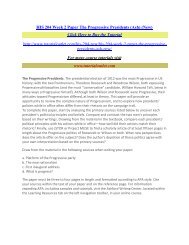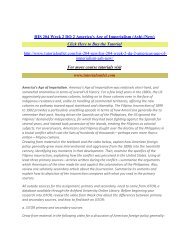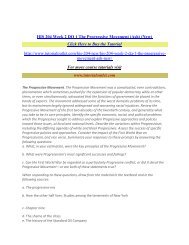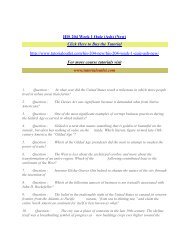HIS 204 Week 3 DQ 1 Normalcy and the New Deal (Ash) (New) / Tutorialoutlet
For more course tutorials visit www.tutorialoutlet.com Normalcy and the New Deal. When the First World War ended, Americans welcomed what they hoped would be a “return to normalcy.” The decades that followed, however, are ones which would rarely be described as normal, in comparison to what came before or after. During these decades, a struggle ensued within the American nation regarding how best to define the nation’s essential character, as groups like the revived Ku Klux Klan fought a rearguard action to define nationhood solely in terms of white skin and Protestant religion against secularists, Catholics, flappers, “New Negroes,” and others who challenged the traditional order. Immediately thereafter, the New Deal implemented in response to the Great Depression threatened to revolutionize the role of the federal government in lives of the American people, in ways which many Americans believed violated the basic tenets of the Constitution—and others believed were not radical enough. Taken together, the decades from 1920 to 1940 may have transformed the American nation more than any other comparable time period. Review the major social and economic developments in American society during the 1920s and 1930s. Identify the factors which made the 1920s “roar,” and explain how the events of that decade contributed to the outbreak of the Great Depression. Then, describe how Americans responded to the Great Depression, both individually and through the government and other organizations, and assess the effectiveness of their responses. Pay particular attention to New Deal programs, and how the approach of the New Deal changed over the course of the 1930s. Along with the general discussion, address developments across these two decades related to TWO of the following groups: a. Evangelical Protestants
For more course tutorials visit
www.tutorialoutlet.com
Normalcy and the New Deal. When the First World War ended, Americans welcomed what they hoped would be a “return to normalcy.” The decades that followed, however, are ones which would rarely be described as normal, in comparison to what came before or after. During these decades, a struggle ensued within the American nation regarding how best to define the nation’s essential character, as groups like the revived Ku Klux Klan fought a rearguard action to define nationhood solely in terms of white skin and Protestant religion against secularists, Catholics, flappers, “New Negroes,” and others who challenged the traditional order. Immediately thereafter, the New Deal implemented in response to the Great Depression threatened to revolutionize the role of the federal government in lives of the American people, in ways which many Americans believed violated the basic tenets of the Constitution—and others believed were not radical enough. Taken together, the decades from 1920 to 1940 may have transformed the American nation more than any other comparable time period. Review the major social and economic developments in American society during the 1920s and 1930s. Identify the factors which made the 1920s “roar,” and explain how the events of that decade contributed to the outbreak of the Great Depression. Then, describe how Americans responded to the Great Depression, both individually and through the government and other organizations, and assess the effectiveness of their responses. Pay particular attention to New Deal programs, and how the approach of the New Deal changed over the course of the 1930s.
Along with the general discussion, address developments across these two decades related to TWO of the following groups:
a. Evangelical Protestants
- No tags were found...
You also want an ePaper? Increase the reach of your titles
YUMPU automatically turns print PDFs into web optimized ePapers that Google loves.
To summarize your response to <strong>the</strong> prompts above, consider <strong>the</strong> following questions (your<br />
response does not need to respond directly to each specific question, but should touch on <strong>the</strong><br />
various <strong>the</strong>mes implicit in <strong>the</strong> questions):<br />
a. How did American society change in <strong>the</strong> two decades after <strong>the</strong> First World War?<br />
b. How did <strong>the</strong> federal government change in response to those changes?<br />
c. How did <strong>the</strong> American people respond to <strong>the</strong> changing role of <strong>the</strong> federal government?<br />
d. How did <strong>the</strong> <strong>New</strong> <strong>Deal</strong> change over time <strong>and</strong> what alternatives were offered to it?<br />
e. Which groups benefited or suffered most from <strong>the</strong>se changes?<br />
f. Should this period be regarded as having represented a revolutionary moment in American<br />
history?<br />
When responding to <strong>the</strong>se questions, draw material from TWO of <strong>the</strong> following videos:<br />
a. The great depression<br />
b. The roaring twenties<br />
c. The civilian conservation corps<br />
Also, draw from <strong>the</strong> material in at least THREE of <strong>the</strong> following primary sources:<br />
a. Lending a h<strong>and</strong>: A woman remembers hoboes of <strong>the</strong> 1930s<br />
b. Flapper Jane<br />
c. Bonus army marches on Washington, DC 1932<br />
d. “The new Negro”: “When he’s hit, he hits back!”<br />
e. Share our wealth speech<br />
f. An open letter to <strong>the</strong> honorable Alfred E. Smith<br />
g. Hell <strong>and</strong> high schools<br />
h. The double task of Negro womanhood<br />
i. Address of <strong>the</strong> President delivered by radio from <strong>the</strong> White House<br />
j. I’d ra<strong>the</strong>r not be on relief<br />
k. TVA: Electricity for all


